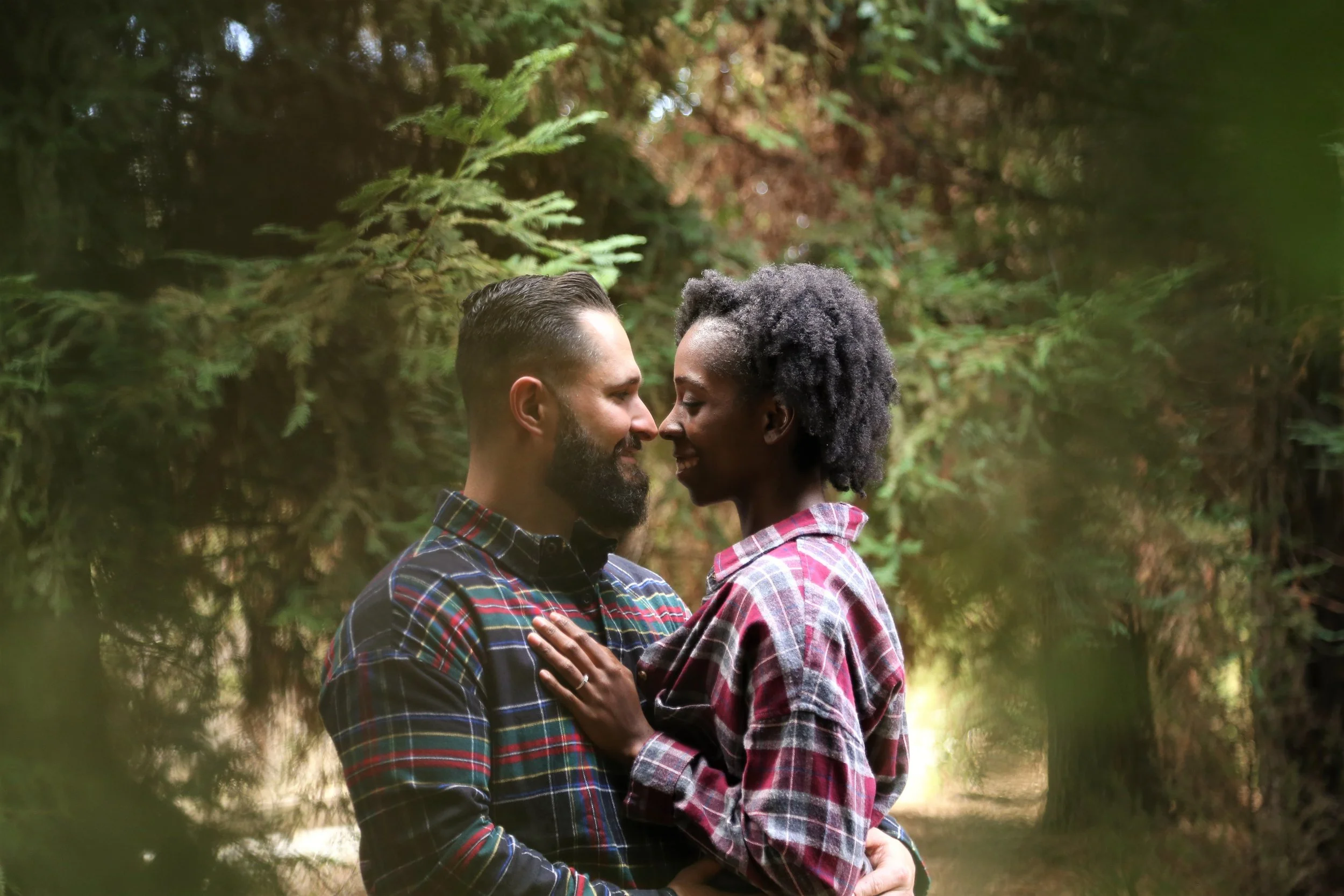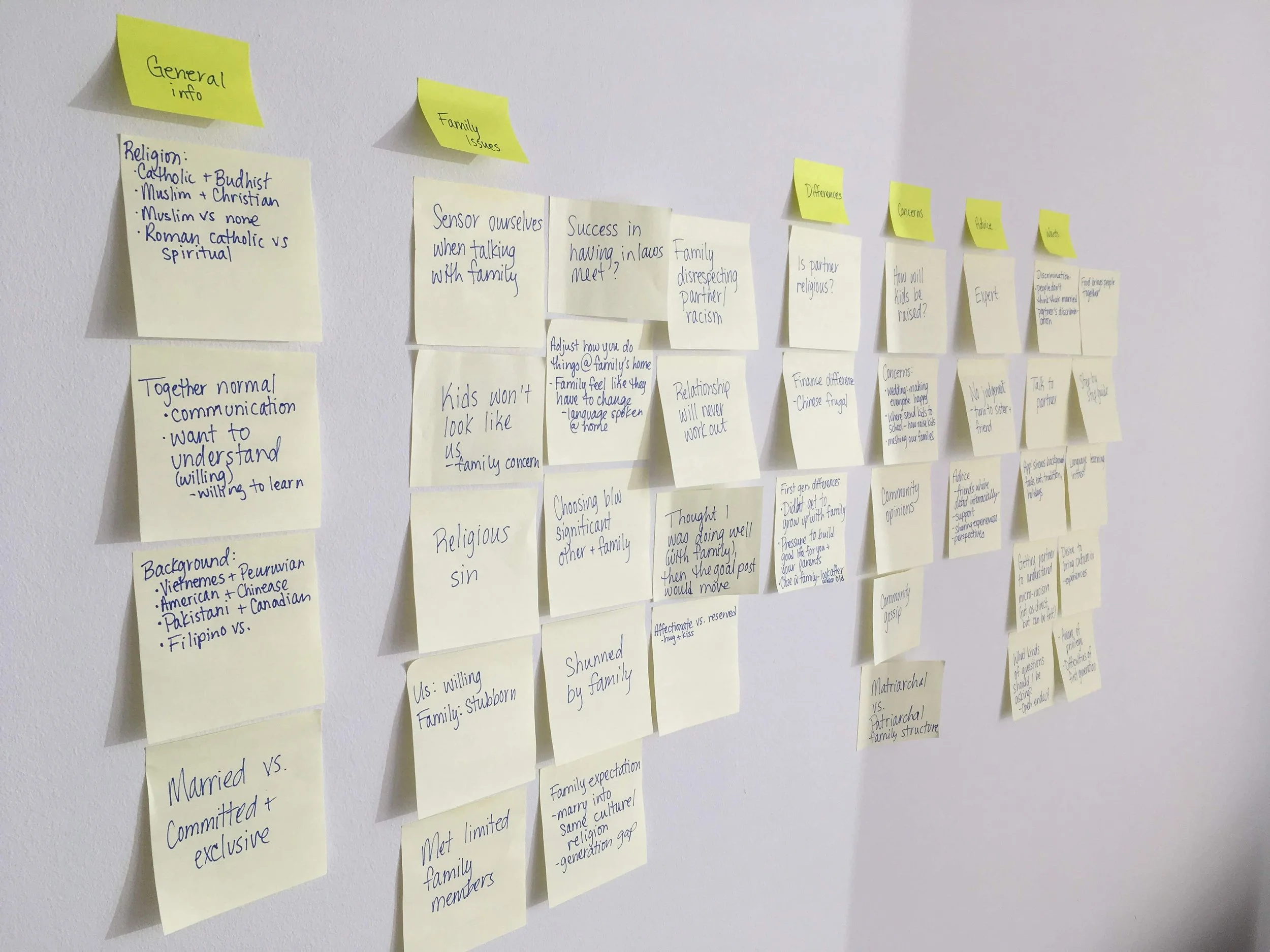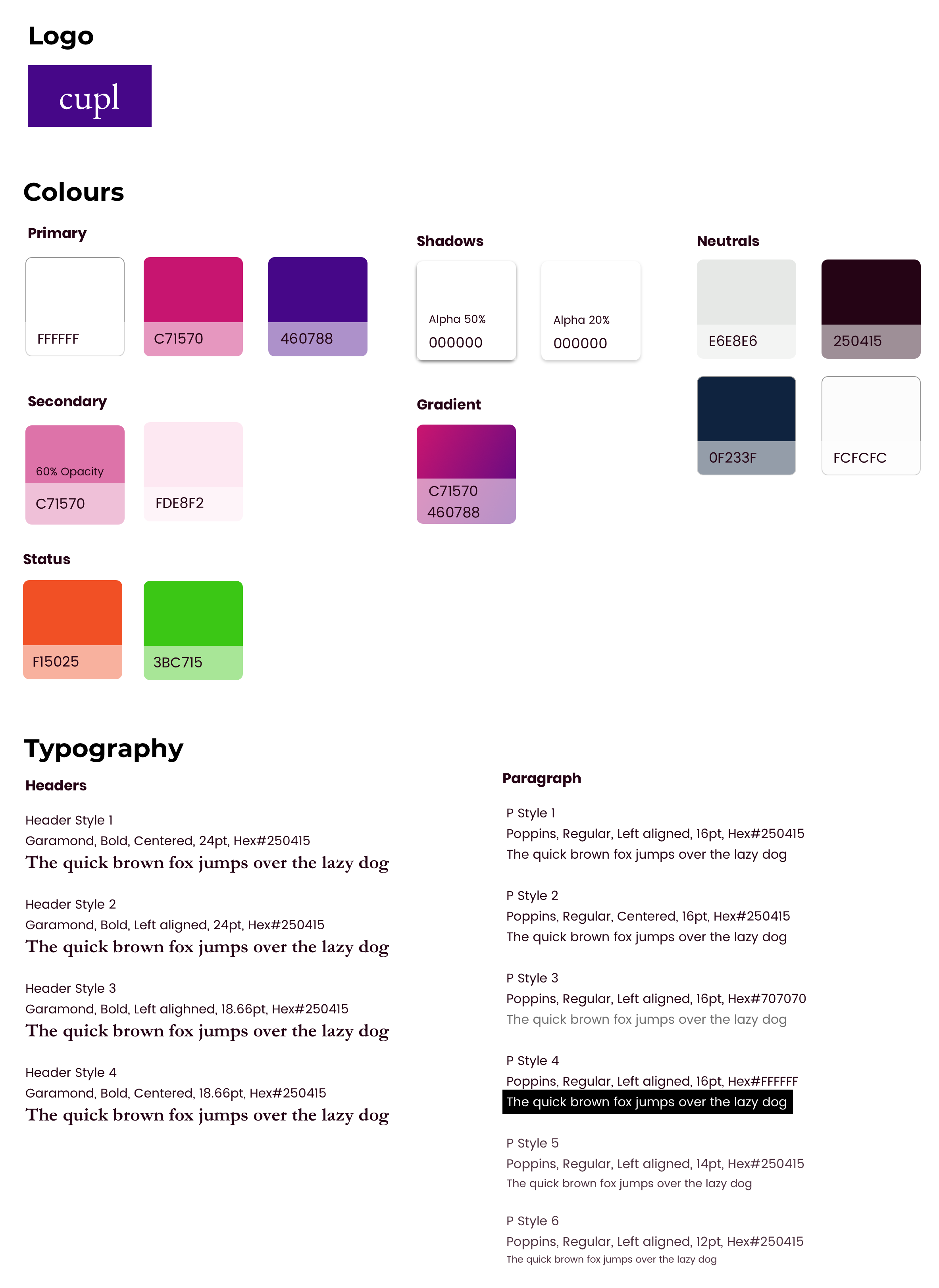Cupl
Cupl is a concept product that focuses on creating a human centered digital solution to help alleviate problems interracial couples face in their daily life.
-
Problem
Interracial relationships are on the rise and society is becoming more inclusive and accepting. However, committed interracial couples still face a spectrum of challenges that are unique. These couples are unable to navigate race and religious based problems as they arise. They need a safe, reliable and inclusive space to access resources and advice.

-
Challenge
How might we provide committed interracial couples guidance and resources that allow them to navigate race and religious based differences?

Project details
-
Duration
10 weeks
-
Role
UX/UI Designer
-
Project
Concept
-
Tools
Sketch
-
Team
None
-
Constraints
Time
Approach
-
Secondary research
Competitor research
Interviews -
Persona creation
Experience map -
User stories
Task flows
Finding inspiration
Sketching
Wireframe -
Interactive prototypes
Test scripts
2 rounds of usability testing -
Brand creation
Moodboard
Inspiration board
Workdmark
UI library
Research
-
Primary
Phone interviews
In person interviews
Mockup walkthroughs
Wireframe walkthroughs
Usability testing
A/B Testing -
Secondary
Online research
News articles
Research articles
Statistics publications
Mobile application stores (Android and iOS)
UI inspiration
Research goals
-

Define
Define interracial relationship
-

Competitive analysis
Learn about existing relationship support apps
-

Demographic
Understand the demographic affected
-

Motivations
Determine user needs and frustrations
-

Opportunity
Identify areas of opportunity
Secondary research findings
-

Interracial relationship definition
One partner belongs to a visible minority where the other does not OR both belong to different visible minority groups.
-

Demographics
360,045 of all married & common-law couples in Canada were in mixed unions
25-34 is the primary age range. These people live & interact in integrated settings.
2x as many Toronto couples are in mixed marriages compared to the rest of Canada. -

Need
Support is critical to interracial relationship success
-

Frustrations
Open hostility, negative stereotyping, negative comments, sense of isolation & rejection
Competitor Analysis
Analysis
There are not any direct competitors. There is an opportunity to use mobile-based tech to support couples in committed interracial relationships, since there is nothing dedicated to interracial couple support. Couples are not encouraged to discuss answers outside of the indirect competitors. Counsellors do not have domain specific knowledge ie how to face race and religious based differences.
Happy Couple
Rating: 4.1/5 (144 reviews)
Features: Promotes communication among couples by asking couples 5 questions/day. These questions are aimed to build a dialogue about feelings, values and aspirations.
Strengths: free of charge. Answer questions then discuss responses.
Weaknesses: Get to know each other better via smartphone. Duplicate questions frequently appear.
ReGain - Couple’s Therapy
Rating: 4.7/5 (853 reviews)
Features: Experts have doctoral degrees or are licensed professional counsellors. Each session the couple and counsellor are assigned an online “room.”
Strengths: Counsellors are available 24/7.
Weaknesses: Cost is $40-70/week and billed monthly. Counselling offered both individually and with partner; however, I believe both should be included to promote communication & relationship health. Not specialized for specific types of relationship problems.
Primary research
I interviewed 9 people who are in or have been in an interracial relationship. Once completed, I clustered responses to find overarching themes and patterns.
Themes
-

Communication
Open and frequent communication was an indicator of healthy interracial relationships.
-

Peer experiences
Couples placed greater value on advice from individuals who have experienced their challenges & overcame them.
-

Family issues
Significant family issues ie. racism, altering one’s behaviours, expectations & shunning.
-

Future concerns
Future concerns ie. wedding practices, raising children & meshing families.
-

Differences
Differences between partners ie. desire to understand differences, discrimination experienced by partner & cultural differences.
Sympathetic peers
-
“Most of our friends are in interracial relationships, or have been at some point, so they are in support of interracial relationships.”
-
“[I] turn to my closest friends because they have dated interracially [and] understand where I’m coming from. [They’re a] source of support [and are] judging based on who you are as a person [and] compatibility. Race is not a thing at all.”
-
“My friends are skeptical about how long the relationship will ask. Maybe you should be with a brown guy. Speak that language.”
Family differences
-
“The family expectation [is to] marry into the same culture.”
-
“[With family, it’s a] generational gap. They can’t wrap their head around it.”
-
“How did you get your families to be willing to understand each other? Get them to have an open mind?”
-
“He had to choose between his significant other and his family. Happy medium – we never came to. [We were] in the relationship for over three years.”
-
“[My partner’s family] asked me if I was a Canadian citizen. Asked if I celebrate any of the Indian holidays. When I said that I didn’t because of religion, his mom was surprised and said “I don’t believe in that shit” (she meant religion or God)… Fun fact: my ex’s mom called me exotic once. I felt like a bird.”
-
“I have been shunned by my family. They try everything to bring me back or to change my mind. [I have] to make my partner understand where my parents are coming from. I had to make her understand that they do not hate her for who she is as a human. It has to do with her culture, religion and way of living. [I want] strategies that I can use to convince my parents to accept us.”
-
“The wedding aspect scares me a bit. I don’t know how to make it ok for everyone and everyone to be happy. [There are other challenges that will arise such as] what kind of school to send [kids] to: Public or Catholic. Biggest [concern] is meshing the family. Our families have not met each other… Don’t know how that would go. Makes me scared.”
-
“[There was an] us vs. them mentality. What bridged the gap between larger families? Where there any things that they said ‘that’s just the way it’s going to be.’ How do you accept that difference, despite stress, for the sake of the relationship?
Communication
-
“I find good communication is what helps us the most.”
-
“Discrimination [is] almost always [directed] towards her. Hard to understand and support her in a way that will best encourage her. Supporting each other – whoever is receiving more of the discrimination.”
-
“Communication is important [between my partner and I].”
-
“What kind of questions should I be asking as we progress in our relationship?”
User persona
Focusing on common experiences and averaging data, I created a user persona that helped guide the product functions.
User stories
Next, I made 50 user stories which assisted in creating core tasks to accomplish user goals: improving communication within the couple and connecting couples who share experiences and who are able to provide real-life advice.
“As a person in an interracial couple, I want to ask advice from couples who have been through similar challenges so that we can learn how to tackle them ourselves.”
“As a partner, I want to have a place we can come together to discuss difficult conversations so that we continue growing as a couple.”
Task flows
Primary and secondary
Inspiration
With the task flows in mind, I found inspiration on Dribble, Pattrns, Sketch App Sources, and Uplabs. Inspiration includes login screens, components, card layouts, matching modals & copy.
Initial sketches
Next, low-fidelity wireframes were created using a pen and paper. Sketches of primary & secondary task flow wireframes (read: right to left and top to bottom).
Iterate & test
-
Medium-fidelity wireframes were created in Sketch. Using these, I created a prototype using Invision which allowed me to test usability.
-
The med-fi prototype was tested to see if the app works as intended and to gain insights from users. I conducted two rounds of user testing which was done both in person and remotely. In order to understand how a person in an interracial relationship may interact with the app, I provided users with a tester’s persona to allow them better context.
-
“I want you to imagine that you are Rachel. You have been in an interracial relationship for one year and are committed to making it work. Your parents do not like that you are with someone of a different religion, ethnicity and background, but you are happy. Sometimes your partner does not understand your perspective, so you’ve decided to complete weekly check ins with one another since it prompts questions that promote new conversations. It is now time for your check in.”
-
Next, I provided testers with missions to complete. These missions included:
Create an account
Complete weekly check in
View results
Find couples like you
Open chat
First round of testing
Second round of testing
Adapting
Testers felt that the Cupl Matching task flow portion of the app resembled a dating app. However, this is not a dating app but an app intended to strengthen pre-existing interracial relationships. I decided to move away from the tinder-face style design and created a new layout. The carousel style was better, but it still had a dating app feel. Next I created a list view, which solved the problem.
Visual design
After updating my wireframes to incorporate recommendations, I moved on to visual design. During testing, users mentioned that the Check In function of the app had a test-like feel. I overcome this obstacle by creating a playful UI that is upbeat, positive and colourful like the couples themselves.
Up until this point, my prototype lacked a colour scheme, typography, and a brand identity. I created a moodboard from images I collected on Unsplash and Pexels. I pulled colours and created a palette that was AA WCAG accessibility compliant. I conducted two rounds of AB Testing with users to ensure that colours were pleasing to both genders and maintained the upbeat nature of the brand.
Moodboard reflects brand feelings of inclusion, diversity and fun.
UI development
Next, I started brainstorming logos. The marketing site’s creation helped with the formation of the overall brand; and was therefore a determining factor in choosing the logo design. After completing the UI aspect of the app and having finalized the UX designs and flows, I created a UI library which continues to change as the project develops and grows.
Final designs
Once the branding was applied to the wireframes, I had a high-fidelity prototype.
Marketing site
Following the completion of the app, I created a product marketing site.
Process:
Moodboard
Inspiration board
Sketches
Wireframes
AB testing
User testing
Incorporated user feedback
Impact
Interracial couples have a platform to discuss issues and gain real world insights from experienced interracial couples. Couples can also gain a better understanding of each other’s perspectives and experiences.
Learnings
Adhering to design patterns is often good practice; however, it was a challenge to be overcome in this project. Replicating dating app ‘matching’ led users to misinterpret the goals of the app and this led to confusion. User feedback is key in creating an app. I also enjoyed entering a problem space lacking ideas about what the final product would be. I allowed the interviews and research to drive the project and create something of value for the users.
Beyond
-

Next steps
While the feedback was mostly positive from users, I plan on fleshing out the rest of the pages of the prototype, especially the Check In and Profile features. I plan to continue the iterative cycle of testing and updating the prototype.
Cupl can also be created for other platforms such as watch, tablet and web applications.
-

Future thinking
How might cultural habits change how your product is used?
Ideally, Cupl would become obsolete. If interracial relationships became mainstream and racism and difference were no longer societal issues, there would be no problem space. I look forward to a day when this becomes true.
And how might your product change cultural habits?
Cupl encourages people to discuss their differences to gain a better understanding of one another.
What’s the worst headline about your product you can imagine?
I managed to get away from the tinder-face UI. Regardless of appearances, the worst thing that could happen is that the app is used as a dating app or a swinger site. It’s purely advice based, people!
Who or what disappears if your product is successful?
The need for interracial couples to get advice from counsellor, well-meaning family and friends would disappear if Cupl became successful. Unless you’ve been in another’s shoes, it’s difficult to give advice on the complex issues that interracial couples face.
Credits
Statistics Canada
Firebaugh Rose, S., Firmin, M.W., (2013). A Qualitative Study of Interracial Dating Among College Students. International Journal of Sociology of Education, 2(1), 6792. doi: 10.4471/rise.2013.22
Happy Couple
ReGain
Future Thinking questions: The Tarot Cards of Tech




















